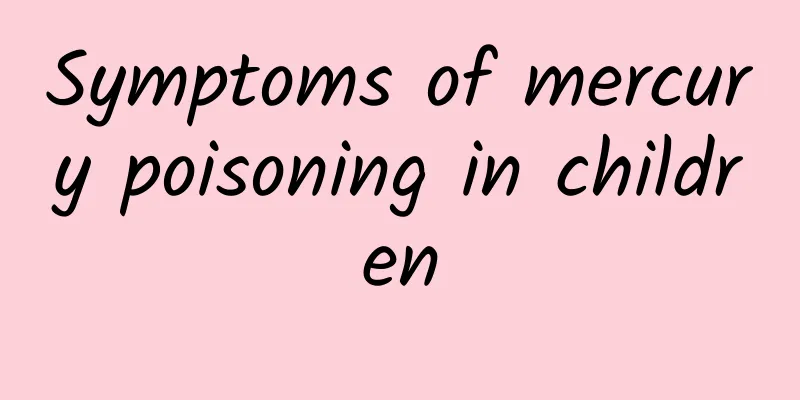Symptoms of mercury poisoning in children

|
Mercury is the only liquid metal at normal temperature and pressure. Mercury is highly toxic. For some children, they are active by nature. If they accidentally ingest mercury, it will often lead to acute poisoning, which will cause greater damage to the respiratory tract. The child will have coughing and fever, and will cause respiratory distress and other symptoms. It will also cause strong corrosion to the stomach and intestines. At this time, emergency methods must be taken for treatment. 1. Acute poisoning Symptoms of acute oral poisoning are: 1. Respiratory tract damage: Inhalation of large amounts of mercury vapor can cause corrosive damage to the respiratory tract, resulting in interstitial pneumonia and bronchiolitis. Children may experience coughing, respiratory distress, and fever. 2. Gastrointestinal symptoms: manifested as acute corrosive gastroenteritis. First, there is tightness and pain in the oropharynx, nausea and vomiting, and the vomitus contains gray mucus and bloody mucosal fragments. Abdominal pain, diarrhea, watery or bloody diarrhea, stools with mucus and blood, and containing large amounts of exfoliated intestinal mucosa, a feeling of tenesmus, similar to dysentery stools. Some patients even develop diffuse peritonitis due to gastrointestinal perforation. The child's tongue, sublingual gland and parotid gland are swollen, bloody mucus flows out of the mouth, there is a metallic taste in the mouth, the oral mucosa may be congested, edematous and necrotic, and the gums may be swollen. Bleeding and ulceration. 3. Nervous system: headache, dizziness, apathy, decreased vision, double vision, etc. In severe cases, convulsions, delirium, or even coma may occur. 4. Kidney disease: manifested as necrotizing nephropathy. Edema, oliguria or anuria, proteinuria, hematuria, tubular urine, azotemia, hyperkalemia, acidosis and other manifestations of acute renal failure often appear 4 to 10 days after poisoning, which are life-threatening. 5. Others: The child has a weak and irregular pulse, difficulty breathing, etc. Severe cases may cause severe acidosis, myocardial damage, heart failure, shock, coma, and convulsions. 2. Chronic mercury poisoning is rare in children. However, acrodynia and Minamata disease are syndromes of chronic poisoning in infants and young children, and Minamata disease is a central nervous system poisoning caused by methylmercury poisoning. 1. Limb pain: (1) Psychiatric and neurological symptoms: may include mental retardation, irritability, apathy, photophobia, sweating, hypertension, hypotonia, neuritis, stomatitis, drooling, gastritis and hair loss. (2) Skin symptoms: various rashes and secondary skin infections. The tips of the fingers and toes and the nose are initially pink, and the cheeks and nose tip are often scarlet. Later, the hands and feet become dark red with patchy ischemic and congested areas, peeling of the palms and soles, itchy skin and severe pain in the hands and feet, and even shedding of the nails and toenails, and necrosis of the extremities. (3) Other symptoms: tachycardia and myocardial damage are common. Tendon reflexes are normal or hyperreflexic at first, but disappear later. Fever may occur occasionally. Peripheral leukocytosis, proteinuria and glucosuria may be seen. 2. Minamata disease: A central nervous system poisoning disease caused by methylmercury poisoning caused by ingestion of fish and shellfish from mercury-contaminated river water. It was first discovered in Minamata Bay (Minamata Bay) in Japan, hence the name. (1) Main manifestations: sensory disturbances, pain, numbness of extremities, hearing and speech disorders, slurred speech, deafness, difficulty chewing and swallowing, visual impairment, movement disorders, weakness, ataxia, hemiplegia, tremor, incoordination of hands and feet, and even difficulty walking, photophobia, abnormal personality, mental retardation, mental retardation, confusion, convulsions, etc. In severe cases, there may be mental disorder, schizophrenia, convulsions, and finally death. (2) Infant Minamata disease: When pregnant women eat fish, shellfish and other aquatic organisms from waters contaminated by mercury, methylmercury can enter the baby's body through the placenta or breast milk, causing poisoning of the baby and central nervous system dysfunction. Soon after birth, the sick baby will develop varying degrees of paralysis and intellectual disability, severe mental retardation, coordination disorders, ataxia, difficulty walking, difficulty speaking, chewing and swallowing, poor growth and development, muscle atrophy, grand mal epilepsy, strabismus and laughter. The methylmercury content in their hair, blood and urine is all elevated. In mild cases, the disease manifests as slow growth, with high levels of methylmercury in the hair, blood, and urine. If the urine contains 0.02 mg/L of mercury, this can usually confirm the disease. |
<<: What are the symptoms of cauliflower disease?
>>: Symptoms of Schizotypal Disorder
Recommend
The pros and cons of daily sex
A moderate sex life is more beneficial to the bod...
What to do if you have a cold and runny nose during breastfeeding? Daily conditioning methods
If a mother catches a cold and has a runny nose d...
No matter whether you are a man or a woman, you cannot be so "lewd"
The Six Evils are a general term for the six exog...
What should I do if my palms are itchy due to urticaria?
Urticaria can be said to be a skin disease. Clini...
The benefits of carrot leaves
Radish leaves have certain therapeutic effects an...
TCM treatment of endometrial thickening
The occurrence of endometrial thickening means th...
Is sesame oil effective for hemorrhoids?
Sesame oil is a relatively common vegetable oil. ...
Precautions for Preexcitation Syndrome: Good living habits are crucial!
Preexcitation syndrome is a very harmful disease,...
Is gastric ulcer serious? Pay attention to complications
If you do not pay attention to your diet and love...
What causes sudden vomiting and dizziness? Five reasons to pay attention to
In life, some people will experience sudden sympt...
Astragalus membranaceus
The medicinal value of Inner Mongolia Astragalus ...
Children with poor immunity should learn to eat like this
Children nowadays often catch colds and get sick ...
What medicine can I take to shrink uterine fibroids?
The presence of uterine fibroids can cause great ...
How can I have an abortion?
Some female friends become pregnant unexpectedly ...
Is it okay to take ceftriaxone for mycoplasma infection?
Mycoplasma infection is quite common in our daily...









